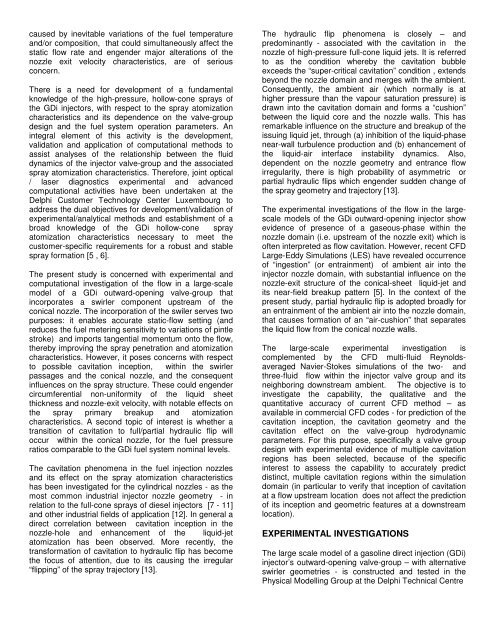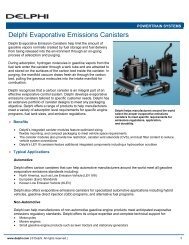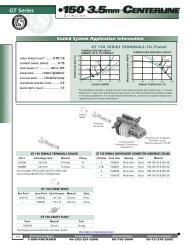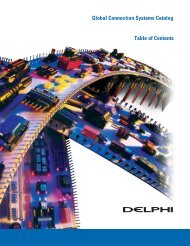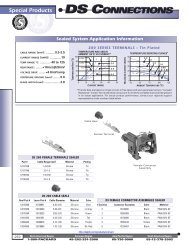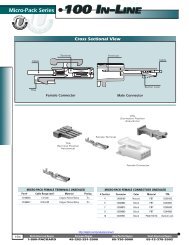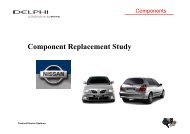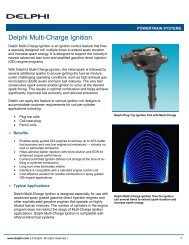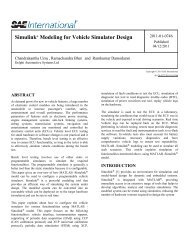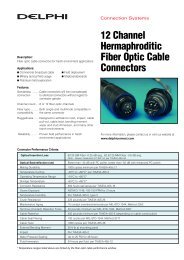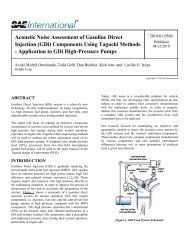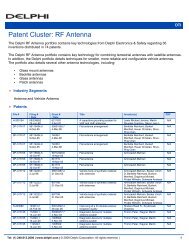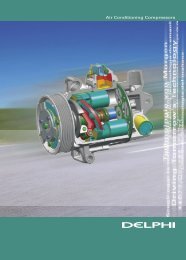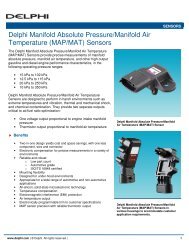Cavitation and Hydraulic Flip in the Outward-Opening GDi ... - Delphi
Cavitation and Hydraulic Flip in the Outward-Opening GDi ... - Delphi
Cavitation and Hydraulic Flip in the Outward-Opening GDi ... - Delphi
You also want an ePaper? Increase the reach of your titles
YUMPU automatically turns print PDFs into web optimized ePapers that Google loves.
caused by <strong>in</strong>evitable variations of <strong>the</strong> fuel temperature<br />
<strong>and</strong>/or composition, that could simultaneously affect <strong>the</strong><br />
static flow rate <strong>and</strong> engender major alterations of <strong>the</strong><br />
nozzle exit velocity characteristics, are of serious<br />
concern.<br />
There is a need for development of a fundamental<br />
knowledge of <strong>the</strong> high-pressure, hollow-cone sprays of<br />
<strong>the</strong> <strong>GDi</strong> <strong>in</strong>jectors, with respect to <strong>the</strong> spray atomization<br />
characteristics <strong>and</strong> its dependence on <strong>the</strong> valve-group<br />
design <strong>and</strong> <strong>the</strong> fuel system operation parameters. An<br />
<strong>in</strong>tegral element of this activity is <strong>the</strong> development,<br />
validation <strong>and</strong> application of computational methods to<br />
assist analyses of <strong>the</strong> relationship between <strong>the</strong> fluid<br />
dynamics of <strong>the</strong> <strong>in</strong>jector valve-group <strong>and</strong> <strong>the</strong> associated<br />
spray atomization characteristics. Therefore, jo<strong>in</strong>t optical<br />
/ laser diagnostics experimental <strong>and</strong> advanced<br />
computational activities have been undertaken at <strong>the</strong><br />
<strong>Delphi</strong> Customer Technology Center Luxembourg to<br />
address <strong>the</strong> dual objectives for development/validation of<br />
experimental/analytical methods <strong>and</strong> establishment of a<br />
broad knowledge of <strong>the</strong> <strong>GDi</strong> hollow-cone spray<br />
atomization characteristics necessary to meet <strong>the</strong><br />
customer-specific requirements for a robust <strong>and</strong> stable<br />
spray formation [5 , 6].<br />
The present study is concerned with experimental <strong>and</strong><br />
computational <strong>in</strong>vestigation of <strong>the</strong> flow <strong>in</strong> a large-scale<br />
model of a <strong>GDi</strong> outward-open<strong>in</strong>g valve-group that<br />
<strong>in</strong>corporates a swirler component upstream of <strong>the</strong><br />
conical nozzle. The <strong>in</strong>corporation of <strong>the</strong> swiler serves two<br />
purposes: it enables accurate static-flow sett<strong>in</strong>g (<strong>and</strong><br />
reduces <strong>the</strong> fuel meter<strong>in</strong>g sensitivity to variations of p<strong>in</strong>tle<br />
stroke) <strong>and</strong> imports tangential momentum onto <strong>the</strong> flow,<br />
<strong>the</strong>reby improv<strong>in</strong>g <strong>the</strong> spray penetration <strong>and</strong> atomization<br />
characteristics. However, it poses concerns with respect<br />
to possible cavitation <strong>in</strong>ception, with<strong>in</strong> <strong>the</strong> swirler<br />
passages <strong>and</strong> <strong>the</strong> conical nozzle, <strong>and</strong> <strong>the</strong> consequent<br />
<strong>in</strong>fluences on <strong>the</strong> spray structure. These could engender<br />
circumferential non-uniformity of <strong>the</strong> liquid sheet<br />
thickness <strong>and</strong> nozzle-exit velocity, with notable effects on<br />
<strong>the</strong> spray primary breakup <strong>and</strong> atomization<br />
characteristics. A second topic of <strong>in</strong>terest is whe<strong>the</strong>r a<br />
transition of cavitation to full/partial hydraulic flip will<br />
occur with<strong>in</strong> <strong>the</strong> conical nozzle, for <strong>the</strong> fuel pressure<br />
ratios comparable to <strong>the</strong> <strong>GDi</strong> fuel system nom<strong>in</strong>al levels.<br />
The cavitation phenomena <strong>in</strong> <strong>the</strong> fuel <strong>in</strong>jection nozzles<br />
<strong>and</strong> its effect on <strong>the</strong> spray atomization characteristics<br />
has been <strong>in</strong>vestigated for <strong>the</strong> cyl<strong>in</strong>drical nozzles - as <strong>the</strong><br />
most common <strong>in</strong>dustrial <strong>in</strong>jector nozzle geometry - <strong>in</strong><br />
relation to <strong>the</strong> full-cone sprays of diesel <strong>in</strong>jectors [7 - 11]<br />
<strong>and</strong> o<strong>the</strong>r <strong>in</strong>dustrial fields of application [12]. In general a<br />
direct correlation between cavitation <strong>in</strong>ception <strong>in</strong> <strong>the</strong><br />
nozzle-hole <strong>and</strong> enhancement of <strong>the</strong> liquid-jet<br />
atomization has been observed. More recently, <strong>the</strong><br />
transformation of cavitation to hydraulic flip has become<br />
<strong>the</strong> focus of attention, due to its caus<strong>in</strong>g <strong>the</strong> irregular<br />
“flipp<strong>in</strong>g” of <strong>the</strong> spray trajectory [13].<br />
The hydraulic flip phenomena is closely – <strong>and</strong><br />
predom<strong>in</strong>antly - associated with <strong>the</strong> cavitation <strong>in</strong> <strong>the</strong><br />
nozzle of high-pressure full-cone liquid jets. It is referred<br />
to as <strong>the</strong> condition whereby <strong>the</strong> cavitation bubble<br />
exceeds <strong>the</strong> “super-critical cavitation” condition , extends<br />
beyond <strong>the</strong> nozzle doma<strong>in</strong> <strong>and</strong> merges with <strong>the</strong> ambient.<br />
Consequently, <strong>the</strong> ambient air (which normally is at<br />
higher pressure than <strong>the</strong> vapour saturation pressure) is<br />
drawn <strong>in</strong>to <strong>the</strong> cavitation doma<strong>in</strong> <strong>and</strong> forms a “cushion”<br />
between <strong>the</strong> liquid core <strong>and</strong> <strong>the</strong> nozzle walls. This has<br />
remarkable <strong>in</strong>fluence on <strong>the</strong> structure <strong>and</strong> breakup of <strong>the</strong><br />
issu<strong>in</strong>g liquid jet, through (a) <strong>in</strong>hibition of <strong>the</strong> liquid-phase<br />
near-wall turbulence production <strong>and</strong> (b) enhancement of<br />
<strong>the</strong> liquid-air <strong>in</strong>terface <strong>in</strong>stability dynamics. Also,<br />
dependent on <strong>the</strong> nozzle geometry <strong>and</strong> entrance flow<br />
irregularity, <strong>the</strong>re is high probability of asymmetric or<br />
partial hydraulic flips which engender sudden change of<br />
<strong>the</strong> spray geometry <strong>and</strong> trajectory [13].<br />
The experimental <strong>in</strong>vestigations of <strong>the</strong> flow <strong>in</strong> <strong>the</strong> largescale<br />
models of <strong>the</strong> <strong>GDi</strong> outward-open<strong>in</strong>g <strong>in</strong>jector show<br />
evidence of presence of a gaseous-phase with<strong>in</strong> <strong>the</strong><br />
nozzle doma<strong>in</strong> (i.e. upstream of <strong>the</strong> nozzle exit) which is<br />
often <strong>in</strong>terpreted as flow cavitation. However, recent CFD<br />
Large-Eddy Simulations (LES) have revealed occurrence<br />
of “<strong>in</strong>gestion” (or entra<strong>in</strong>ment) of ambient air <strong>in</strong>to <strong>the</strong><br />
<strong>in</strong>jector nozzle doma<strong>in</strong>, with substantial <strong>in</strong>fluence on <strong>the</strong><br />
nozzle-exit structure of <strong>the</strong> conical-sheet liquid-jet <strong>and</strong><br />
its near-field breakup pattern [5]. In <strong>the</strong> context of <strong>the</strong><br />
present study, partial hydraulic flip is adopted broadly for<br />
an entra<strong>in</strong>ment of <strong>the</strong> ambient air <strong>in</strong>to <strong>the</strong> nozzle doma<strong>in</strong>,<br />
that causes formation of an “air-cushion” that separates<br />
<strong>the</strong> liquid flow from <strong>the</strong> conical nozzle walls.<br />
The large-scale experimental <strong>in</strong>vestigation is<br />
complemented by <strong>the</strong> CFD multi-fluid Reynoldsaveraged<br />
Navier-Stokes simulations of <strong>the</strong> two- <strong>and</strong><br />
three-fluid flow with<strong>in</strong> <strong>the</strong> <strong>in</strong>jector valve group <strong>and</strong> its<br />
neighbor<strong>in</strong>g downstream ambient. The objective is to<br />
<strong>in</strong>vestigate <strong>the</strong> capability, <strong>the</strong> qualitative <strong>and</strong> <strong>the</strong><br />
quantitative accuracy of current CFD method – as<br />
available <strong>in</strong> commercial CFD codes - for prediction of <strong>the</strong><br />
cavitation <strong>in</strong>ception, <strong>the</strong> cavitation geometry <strong>and</strong> <strong>the</strong><br />
cavitation effect on <strong>the</strong> valve-group hydrodynamic<br />
parameters. For this purpose, specifically a valve group<br />
design with experimental evidence of multiple cavitation<br />
regions has been selected, because of <strong>the</strong> specific<br />
<strong>in</strong>terest to assess <strong>the</strong> capability to accurately predict<br />
dist<strong>in</strong>ct, multiple cavitation regions with<strong>in</strong> <strong>the</strong> simulation<br />
doma<strong>in</strong> (<strong>in</strong> particular to verify that <strong>in</strong>ception of cavitation<br />
at a flow upstream location does not affect <strong>the</strong> prediction<br />
of its <strong>in</strong>ception <strong>and</strong> geometric features at a downstream<br />
location).<br />
EXPERIMENTAL INVESTIGATIONS<br />
The large scale model of a gasol<strong>in</strong>e direct <strong>in</strong>jection (<strong>GDi</strong>)<br />
<strong>in</strong>jector’s outward-open<strong>in</strong>g valve-group – with alternative<br />
swirler geometries - is constructed <strong>and</strong> tested <strong>in</strong> <strong>the</strong><br />
Physical Modell<strong>in</strong>g Group at <strong>the</strong> <strong>Delphi</strong> Technical Centre


